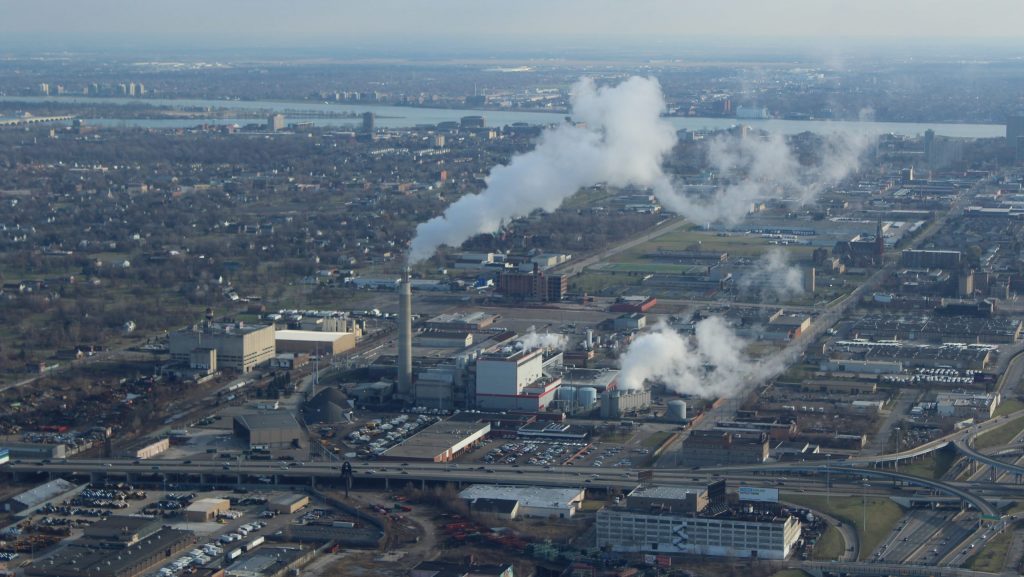Breathe deep? Maybe not in Detroit
Quinn Klinefelter September 12, 2024The Asthma and Allergy Foundation of America rated the Motor City the third worst municipality in the U.S. for those who routinely use an inhaler or nebulizer.

An aerial view of the former Detroit incinerator, which closed in 2019 and was demolished in 2023.
A new study published this week found people with asthma have an especially hard time breathing properly in Detroit.
The Asthma and Allergy Foundation of America rated the Motor City the third worst municipality in the nation for those who routinely need to use an inhaler or nebulizer.
The foundations’ president, Kenneth Mendez, says the group weighed how many people in a city have asthma, how frequently people die from it and the number of times the condition drives residents to visit an emergency room.
“Detroit ranks high in those three areas and that’s one of the reasons why it’s No. 3 on the list.”
– Kenneth Mendez, president of the Asthma and Allergy Foundation of America
Listen: New report ranks Detroit as third worst city in U.S. for those with asthma
The following interview has been edited for clarity and length.
Kenneth Mendez: Detroit ranks high in those three areas and that’s one of the reasons why it’s No. 3 on the list. There’s social determinants of health, there’s family origins related to it, but certainly it really hits communities of color. Black Americans are three times more likely to be diagnosed with asthma, five times more likely to be treated in an emergency room. And Black women have the highest mortality rate of any gender or ethnic group. So those factors really are emblematic of things that we need to do in order to better control our asthma and work with our doctors.
Quinn Klinefelter, WDET News: Are those demographic groups especially at risk because they have less access to good health care? Or because the factories or whatever might produce pollution that could exacerbate asthma happen to be based in communities of color or poorer areas?
KM: There are a number of factors that go into it. Clearly, your zip code, where you live, has an impact. You can tell how long someone’s gonna live from that. But access to care, additional pollution in certain areas is a trigger for asthma. People in some communities can’t afford to live in areas that do not have high levels of pollution. Those are the kinds of things that go into asthma exacerbation and triggers if you have asthma.
QK: Michigan Congresswoman Rashida Talib, for one, has long pushed to get the Environmental Protection Agency to take into account the cumulative impact of pollution in a given area if they’re going to issue a permit through the Clean Air or Clean Water Acts. If that kind of legislation was passed, do you think it would really make a difference?
KM: Let me break that into two pieces. One is, I think the laws and policies will help. The EPA has come out with a “tailpipe rule” to reduce emissions from light trucks and cars, which are significant contributors to bad air and carbon dioxide. So I think having pieces of legislation passed, whether they’re at the federal or at the state level, can be very helpful to those with asthma. For example, in local communities, you can have an idling rule on school grounds basically saying when people are picking up their children, they shouldn’t have their cars idling. Reducing those kind of tailpipe emissions can go a long way towards helping people with asthma and allergies, in particular in some of those communities that are disproportionately impacted.
In the big picture, the longer growing seasons, the additional carbon dioxide, all those things have an impact on allergies. And allergies are a trigger for asthma. Those are the things that through federal policies and legislation we can try and eliminate. The Inflation Reduction Act clearly had some incentives to reduce pollution and try and amplify clean energy alternatives. So those kinds of things can make a difference. Climate change, with the longer growing seasons, more intense releases of pollen because of carbon dioxide, are all triggers for allergies and asthma. A lot of people say, ‘I’ve never had allergies before. They’re getting a lot worse.’ And that’s because of the additional load on your system from those triggers. We need to reduce our carbon footprint. That will go a long way towards reducing asthma and allergies.
Trusted, accurate, up-to-date.
WDET strives to make our journalism accessible to everyone. As a public media institution, we maintain our journalistic integrity through independent support from readers like you. If you value WDET as your source of news, music and conversation, please make a gift today.
